

Looking for a telescope for the next night sky event? We recommend the Celestron StarSense Explorer DX 130AZ as the top pick for basic astrophotography in our best beginner's telescope guide.
The night sky tonight and on any clear night offers an ever-changing display of fascinating objects you can see, from stars and constellations to bright planets, the moon, and sometimes special events like meteor showers.
Observing the night sky can be done with no special equipment, although a sky map can be very useful, and a good telescope or binoculars will enhance some experiences and bring some otherwise invisible objects into view.
You can also use astronomy accessories to make your observing easier, and use our Satellite Tracker page powered by N2YO.com to find out when and how to see the International Space Station and other satellites. We also have a helpful guide on how you can see and track a Starlink satellite train.
You can also capture the night sky by using any of the best cameras for astrophotography, along with a selection of the best lenses for astrophotography.
Read on to find out what's up in the night sky tonight (planets visible now, moon phases, observing highlights this month) plus other resources (skywatching terms, night sky observing tips and further reading)
Related: The brightest planets in the night sky: How to see them (and when)
Monthly skywatching information is provided to Space.com by Chris Vaughan of Starry Night Education, the leader in space science curriculum solutions. Follow Starry Night on Twitter @StarryNightEdu and Chris at @Astrogeoguy
Editor's note: If you have an amazing skywatching photo and would like to share it with Space.com's readers, send your photo(s), comments, and your name and location to spacephotos@space.com.
Calendar of observing highlights
Thursday, Jan. 1 - Full moon passes Elnath

In the eastern sky on Thursday evening, Jan. 1, the bright, nearly full moon will shine very close to the bright star Elnath, which marks the northern horn tip of Taurus, the Bull and also part of the ring-like shape of Auriga, the Charioteer.
During the night, the moon's steady eastward orbital motion around Earth, by about its own diameter every hour, will carry it past the star. Observers located in a zone extending eastward across northern South America and across the South Atlantic Ocean can use binoculars (orange circle) and backyard telescopes to watch the moon occult Elnath. Exact timings will vary by location, so use an app like Starry Night to determine the precise times where you are. In Lima, Peru the dark strip along the leading edge of the moon will cover Elnath at 7:06 p.m. Peru Time (which converts to 00:06 GMT on Friday). The star will emerge from behind the moon's opposite, bright limb at 8:17 p.m. PET. For best results, start watching a few minutes ahead of each time noted.
Saturday, Jan. 3 - Full Wolf supermoon near Jupiter

The January full moon will occur on Saturday, Jan. 3 at 5:03 a.m. EST, 2:03 a.m. PST, or 10:03 GMT while the moon is shining in Gemini near Jupiter.
This full moon is known as the Wolf Moon, Old Moon, and Moon after Yule. The Indigenous Ojibwe people of the Great Lakes region call it Gichi-manidoo Giizis, the "Great Spirit Moon", a time to honor the silence, and recognize one's place within all of Great Mystery's creatures. (You might recall that name from hearing or singing Henry Wadsworth Longfellow's The Song of Hiawatha.) The Cree of North America call the January full moon Opawahcikanasis, the "Frost Exploding Moon", when trees crackle from the extreme cold temperatures. Full moons during the winter months climb as high in the sky at midnight as the summer noonday sun, and cast shadows in the same locations.
This full moon will occur 1.5 days after perigee, making it the final supermoon in a series of four and appearing about 5% brighter and 13% larger than average (red circle).
Saturday, Jan. 3 - Earth at perihelion
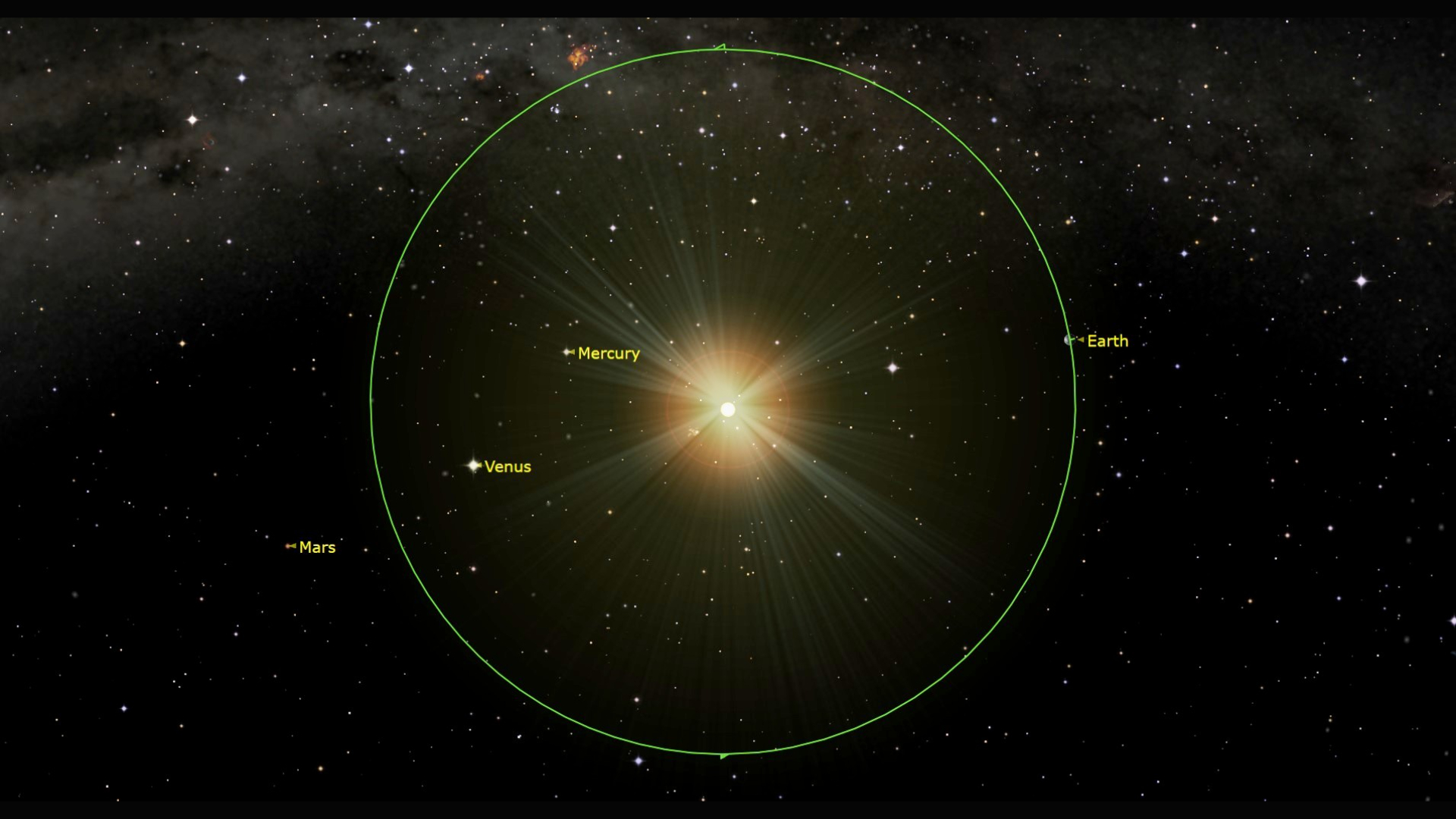
On Saturday, Jan. 3 at 12 p.m. EST, or 9 a.m. PST, or 17:00 GMT, Earth will reach perihelion, its minimum distance from the sun for the year. At perihelion, Earth will be 91.40 million miles (or 147.10 million km) from our star, which is about 1.67% closer than our mean distance of 1.0 Astronomical Unit. As winter-chilled Northern Hemisphere dwellers will attest, daily temperatures on Earth are not controlled by our proximity to the sun, but by the number of hours of daylight we experience.
Saturday, Jan. 3 - Bright moon joins Jupiter (all night)

At dusk on Saturday, Jan. 3, look to the east for the brilliant planet Jupiter shining several finger widths to the lower right (or celestial south) of the bright full moon — cozy enough for them to share the view in binoculars (orange circle). The duo will make a lovely photo opportunity when composed with some nice foreground scenery. As the moon and Jupiter climb higher, the bright stars of winter will appear around them, particularly Pollux and Castor, the bright twins of Gemini on their upper left (celestial north). Both stars are part of the huge winter hexagon asterism. The moon and Jupiter will culminate due south around 12:30 a.m. local time and then set in the west before dawn on Sunday morning. By then, the diurnal rotation of the sky will lift the moon above Jupiter.
Saturday, Jan. 3 - Quadrantids meteor shower peak
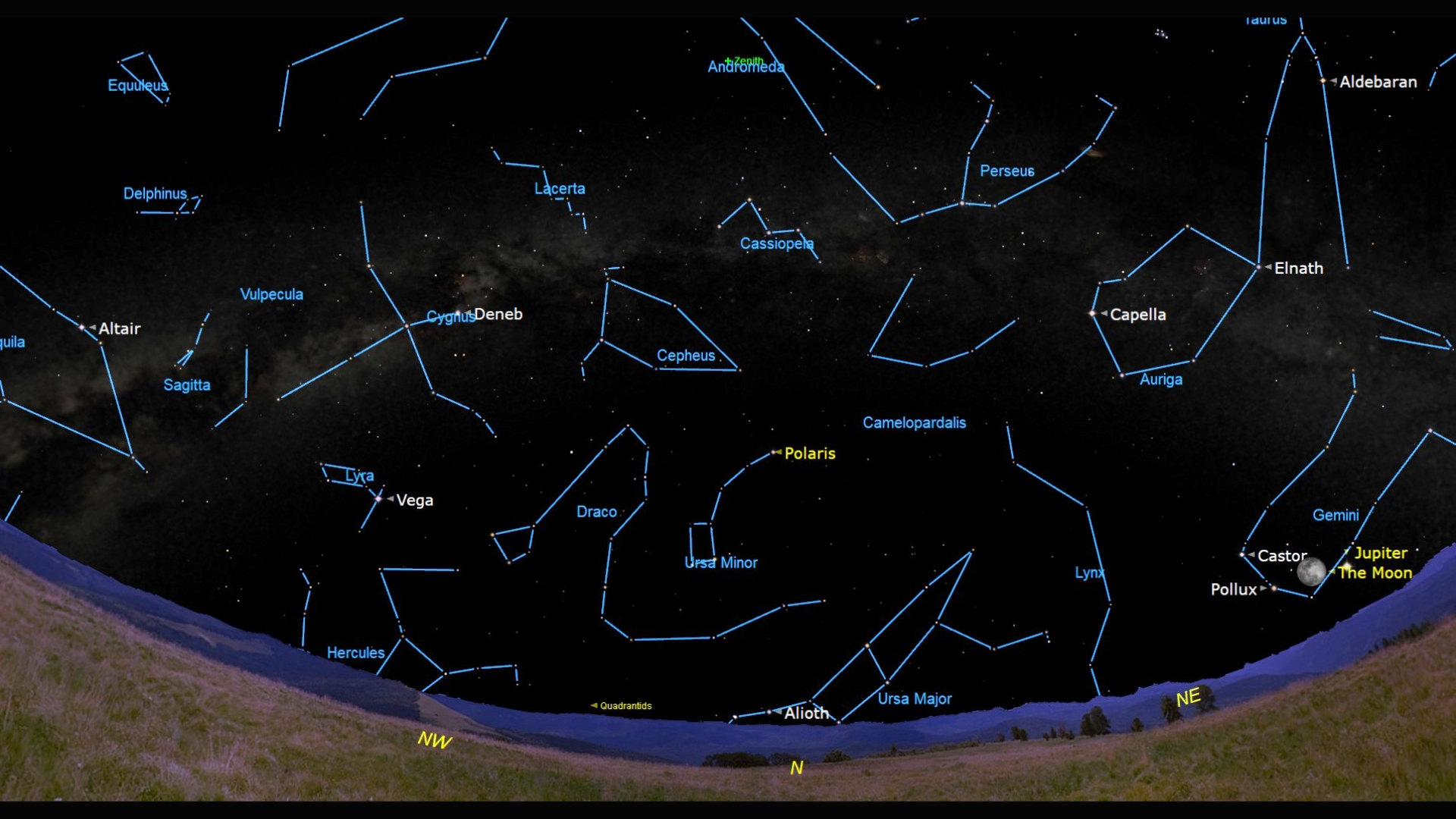
Named for a now-defunct constellation called the Mural Quadrant, the Quadrantids meteor shower runs from Dec. 26 to Jan. 16 every year. Quadrantids meteors always radiate from a point in the sky beyond the tip of the Big Dipper's handle. This shower commonly produces bright fireballs because it is produced by rocky particles dropped by an asteroid designated 2003EH.
The Quadrantids' most intense period, when up to 50 to 100 meteors per hour can appear during a short, 6-hour window, will occur on Saturday, Jan. 3 at 22:00 GMT, which converts to early evening in the Eastern Americas. At that time, the shower's radiant will be close to the northern horizon, halving the number of meteors we see. The bright full moon shining all night long will also reduce the number of Quadrantids seen this year.
Sunday, Jan. 4 - Moon buzzes the Beehive
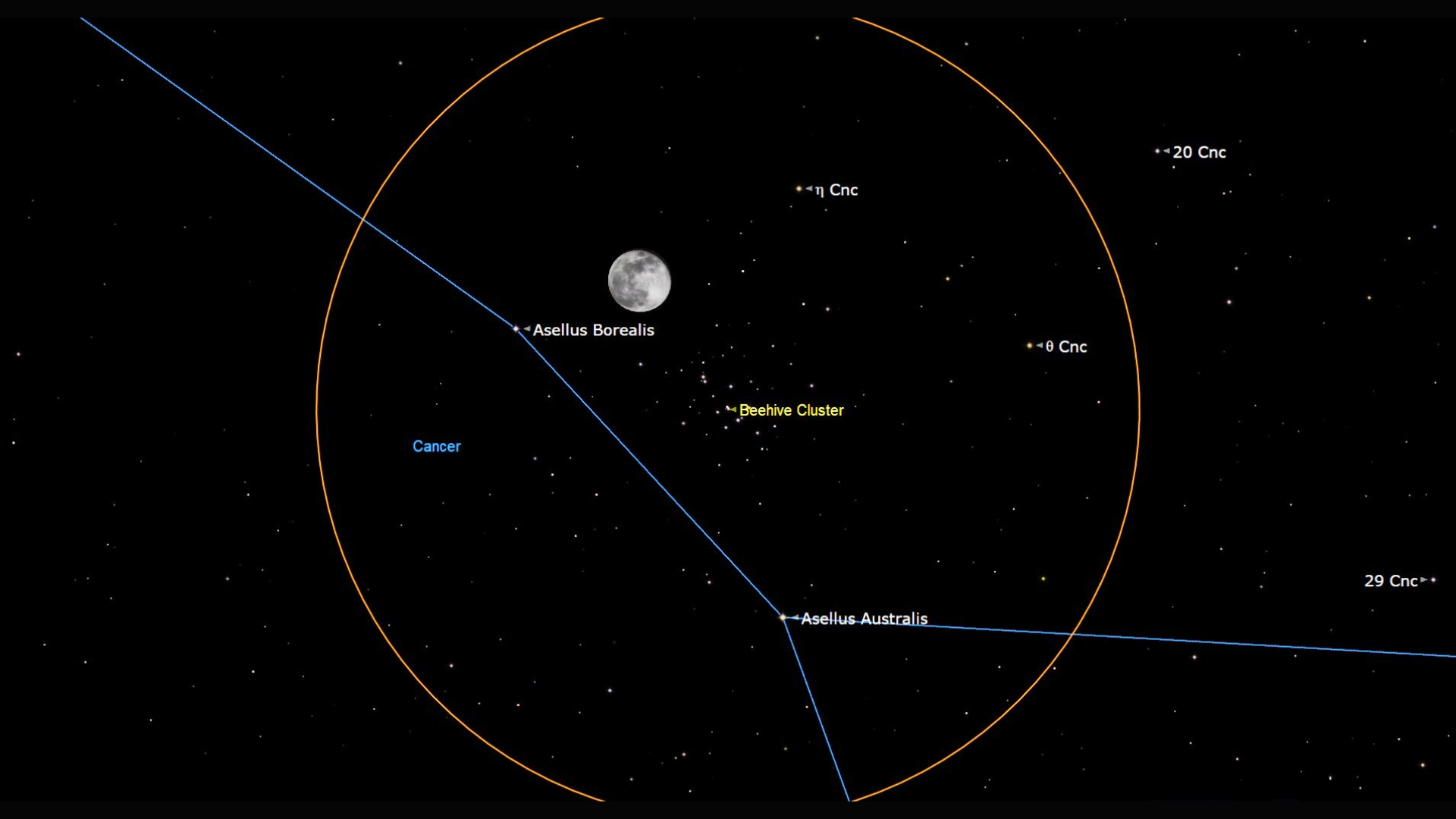
When the bright, waning gibbous moon rises in the east after dusk on Sunday, Jan. 4, it will be positioned a thumb's width to the upper left (about 1.3 degrees to the celestial north) of the large open star cluster in Cancer known as the Beehive, Praesepe, and Messier 44. Both objects will fit within the field of view of binoculars (orange circle), although the bright moonlight will obscure the cluster's dimmer stars. To better see the "bees", which will be scattered across an area more than twice the size of the moon, hide the moon just beyond the upper left edge of the binoculars' field of view.
Monday, Jan. 5 - Gibbous moon over Regulus

When you catch sight of the bright, waning gibbous moon climbing the eastern sky on Monday evening, Jan. 5, look for the very bright star Regulus twinkling about a palm's width below it. That star, the brightest one in Leo, marks the heart of the mythical lion.
While the moon and Regulus are crossing the sky together all night long, the diurnal rotation of the sky will lift Regulus to the moon's upper left by the time they descend the western sky ahead of sunrise on Tuesday morning. Hours later, the moon's eastward orbital motion, by its own diameter every hour (green line), will carry it closer to Regulus and produce an occultation that will be visible in a zone extending from eastern Kazakhstan, across northern China and most of Russia, northeastern Melanesia and Japan on Tuesday evening. In Beijing, China, the leading lit portion of the moon will cover Regulus at 11:47 p.m. Chinese Standard Time. The star will emerge from behind the moon's dark limb at 12:28 a.m. CST. Lunar occultations are perfectly safe to view with unaided eyes and through binoculars and telescopes.
The timing varies by location, so use an app like Starry Night or Sky Safari to look up the occultation timings for your location and be sure to start watching a few minutes ahead of time.
Wednesday, Jan. 7: Stellar halo around Mirfak

On early-January evenings, the constellation of Perseus is overhead. The outer rim of our Milky Way galaxy runs through Perseus' stars, filling its territory with rich star clusters. The largest of them surrounds his brightest star, Mirfak, or Alpha Persei. That elderly yellow supergiant star has evolved out of its blue phase and is now fusing helium into carbon and oxygen in its core. Melotte 20, also known as the Alpha Persei Moving Group and the Perseus OB3 Association, is a collection of 100 or so young, massive, hot B- and A-class stars sprinkled over several finger widths (or 3 degrees) of the sky around Mirfak.
The cluster can be seen with unaided eyes, but it's especially dazzling in binoculars (orange circle). Its stars are approximately 600 light-years from the sun and are moving as a group — Mirfak along with them.
Thursday, Jan. 8 - The stars of Orion's Belt
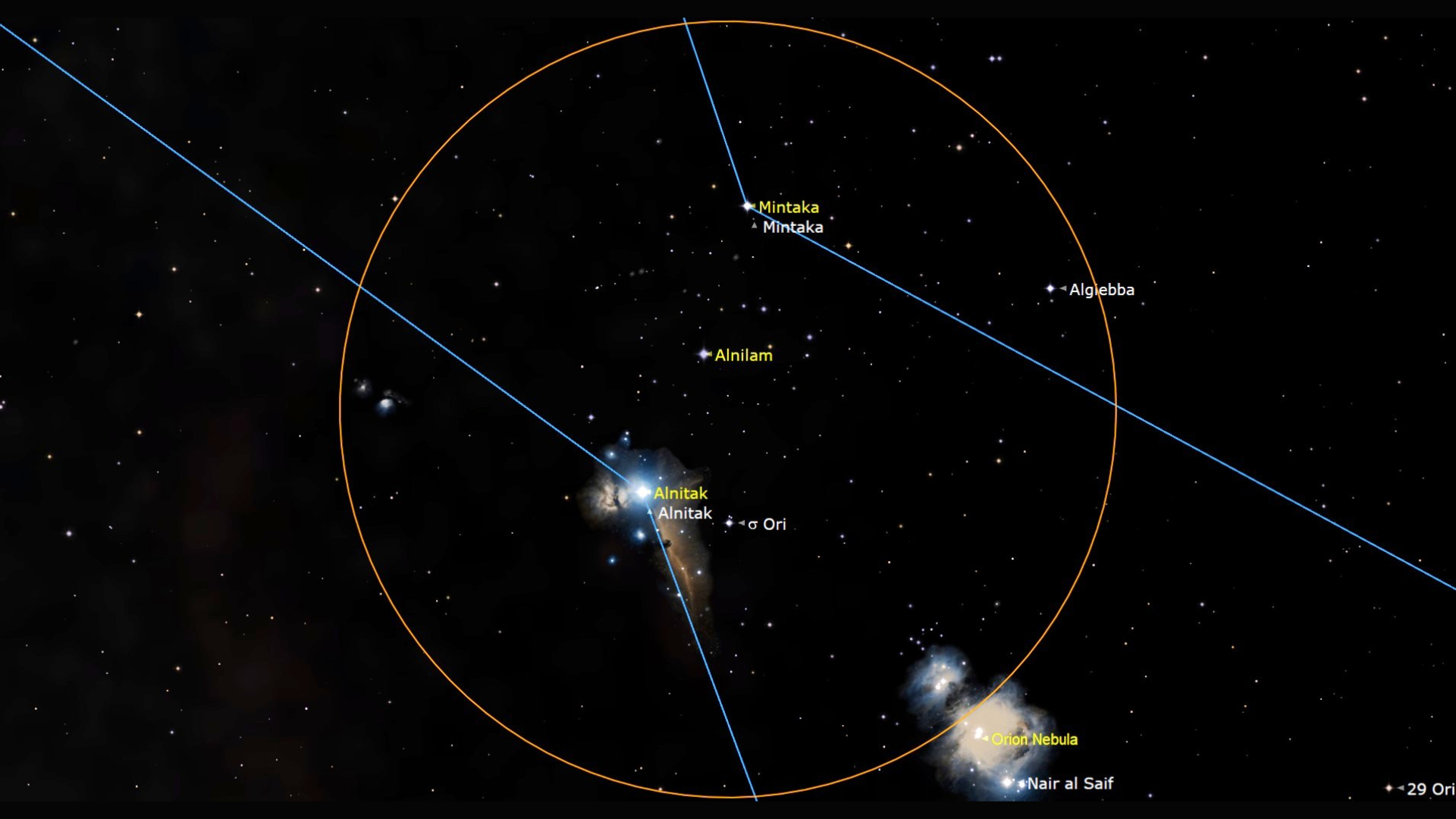
The three stars in Orion's belt may look the same, but they are actually quite different under closer inspection. Magnitude 1.85 Alnitak (Zeta Orionis) on the left and magnitude 1.65 Alnilam (Epsilon Orionis) in the center shine at almost the same brightness, though Alnilam is almost twice as far away. Magnitude 2.4 Mintaka (Delta Orionis) on Orion's right hip is quite a bit fainter. Alnitak is blue, while the other two stars are whiter in color. In a telescope, Alnitak (Arabic for "the Girdle") is revealed to be a very tightly spaced double star, while Mintaka is a more widely spaced pair.
Using binoculars (orange circle) look for a large, upright, S-shaped asterism of dim stars in the space between Alnilam and Mintaka. Sigma Orionis, the medium-bright star sitting less than a finger's width to the lower right (or 0.8 degrees southwest of) Alnitak, is a beautiful little grouping of ten or more stars when viewed under magnification.
Friday, Jan. 9 - Jupiter peaks at opposition (all night)

On Friday night, Jan. 9, in the Americas, Jupiter will reach opposition for 2026 while it gleams brightly near the star Wasat in Central Gemini.
At opposition, planets rise in the east at sunset and cross the sky all night long before setting in the west at sunrise. Jupiter will be at its minimum distance from Earth for this year of 393.4 million miles (633.1 million km) or 35 light-minutes, boosting its brilliance to magnitude -2.7. Viewed in a telescope (inset), the planet will display a generous, 46.6 arc-seconds-wide disk striped with brown equatorial bands. Around opposition, Jupiter and its four large Galilean satellites frequently eclipse and occult one another. Telescope owners can watch them cast their round, black shadows on the planet — singly and in pairs — and the Great Red Spot crossing the planet's disk for a few hours on every second or third night.
Saturday, Jan. 10 - Third quarter moon
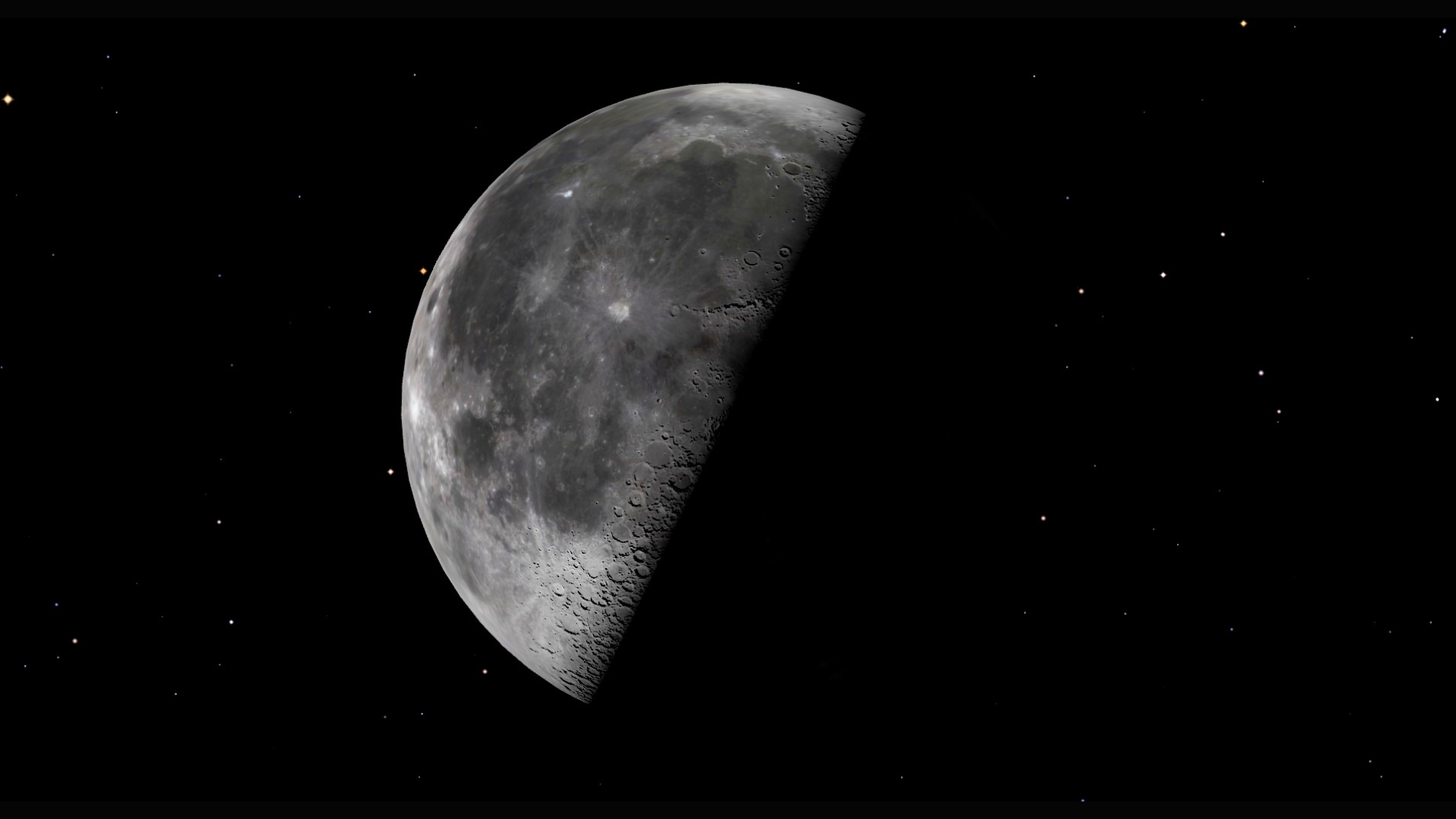
The moon will complete three-quarters of its orbit around Earth, measured from the previous new moon, on Saturday, Jan. 10 at 10:48 a.m. EST, 7:48 a.m. PST, or 15:48 GMT. At its third (or last) quarter phase the moon is half-illuminated, on its western, sunward side.
It will rise around midnight local time and then remain visible until it sets in the western daytime sky during the early afternoon. Early risers on Saturday morning will see Virgo's brightest star Spica, sparkling to the moon's left (or celestial east). Third quarter moons are positioned ahead of the Earth in our trip around the sun. About 3½ hours later, Earth will occupy that same location in space. The week of dark, moonless evenings that follow this phase is ideal for observing the fainter objects in the night sky.
Monday, Jan. 12 - Watch Algol brighten

On January evenings, Perseus is high in the eastern sky after dusk. The star Algol, also designated Beta Persei, marks the glowing eye of Medusa from Greek mythology, and is among the most accessible variable stars for skywatchers.
During a ten-hour period that repeats every 2 days, 20 hours, and 49 minutes, Algol dims noticeably and re-brightens by about a third while a fainter companion star with an orbit nearly edge-on to Earth crosses in front of its much brighter primary, reducing the total light output we perceive. Algol normally shines at magnitude 2.1, similar to the nearby star Almach (aka Gamma Andromedae). But when fully dimmed, Algol's brightness of magnitude 3.4 is almost identical to Rho Persei (or Gorgonea Tertia or ρ Per), the star sitting just two finger widths to Algol's right (or 2.25 degrees to the celestial south). On Monday evening, Jan. 12 at 5:48 p.m. EST (or 22:48 GMT for other time zones), Algol will display its minimum brightness while it is shining nearly overhead above the very bright star Capella. Algol will steadily brighten while it passes the zenith and then begins to descend in the western sky, returning to full intensity by 10:48 p.m. EST (or 03:48 GMT on Tuesday).
Wednesday, Jan. 14 - Crescent moon approaches Antares and Messier 4 (predawn)
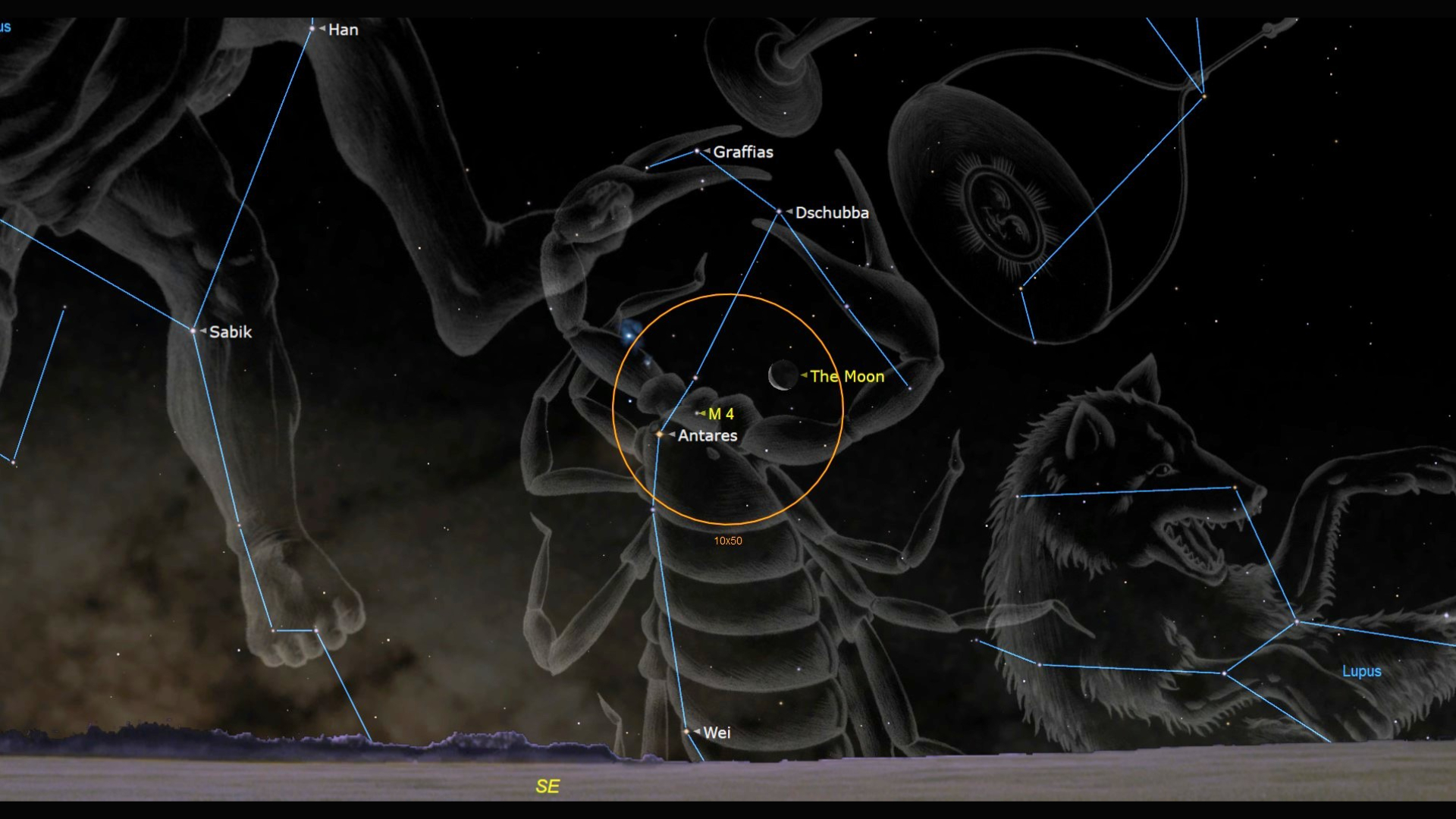
In the southeastern sky on Wednesday morning, Jan. 14, the waning crescent moon will shine prettily below the claw stars of Scorpius and just to the upper right (or celestial west) of the bright, reddish star Antares that marks the scorpion's heart. If your sky is clear, use binoculars (orange circle) to view the duo. Keep an eye out for the large, faint fuzzy patch of the globular star cluster Messier 4 (or M4) that sits a thumb's width to Antares' right. One of the largest and brightest of its kind, it is composed of thousands of stars bound together by mutual gravity, 7,000 light-years away from our solar system. Before dawn on Thursday morning, observers in central Australia can safely watch the moon occult Antares.
Friday, Jan. 16 - The spectacular Orion Nebula

The bright stars of mighty Orion, the Hunter, shine in the southeastern sky during the evening in early January.
Orion's sword, which covers an area of 1.5 by 1 degrees (about the end of your thumb held up at arm's length), descends from Orion's three-starred belt. The patch of light in the middle of the sword is the spectacular and bright nebula known as the Orion Nebula (or Messier 42 and NGC 1976). While binoculars (orange circle) will reveal the fuzzy nature of this object, medium-to-large aperture backyard telescopes will show complex veils of gas and dark dust lanes, and the Trapezium Cluster, a tight clump of young stars that formed from the nebula's collapsing gas. The nebula and its internal stars are located approximately 1,350 light-years from the sun in the Orion arm of our Milky Way galaxy.
Saturday, Jan. 17 - The lost jewel of Orion's Sword

To the unaided eye, a patch of brightness below the Orion Nebula defines the southern tip of Orion's sword. The area is dominated by the bright, magnitude 2.75 star named Nair al Saif, and sometimes called Hatysa, Iota Orionis, and The Lost Jewel of Orion. Just to the lower right (or 8 arc-minutes to the southwest) of Nair al Saif is a pair of magnitude 4 stars named HIP26199 and HIP26197. They are almost 3,000 light-years from the sun and shine with an intense blue light indicative of their extreme surface temperatures.
Astronomers estimate that those two stars are approximately 40,000 times as luminous as our sun. The jewel is also readily seen in binoculars. In a backyard telescope, the entire area is surrounded by faint nebulosity that will be enhanced by a nebula filter.
Sunday, Jan. 18 - New moon in Sagittarius

The moon will reach its new phase on Sunday, Jan. 18 at 2:52 p.m. EST, 11:52 a.m. PST, or 19:52 GMT.
At that time, our natural satellite will be located in eastern Sagittarius and 4 degrees south of the sun. While it's new, the moon is traveling between Earth and the sun. Since sunlight can only reach the far side of the moon, and the moon is in the same region of the sky as the sun, the moon becomes unobservable from anywhere on Earth for about a day (except during a solar eclipse). On the evenings following the new moon phase, Earth's planetary partner will return to shine in the western sky after sunset.
Wednesday, Jan. 21 - Mare Crisium (evening)
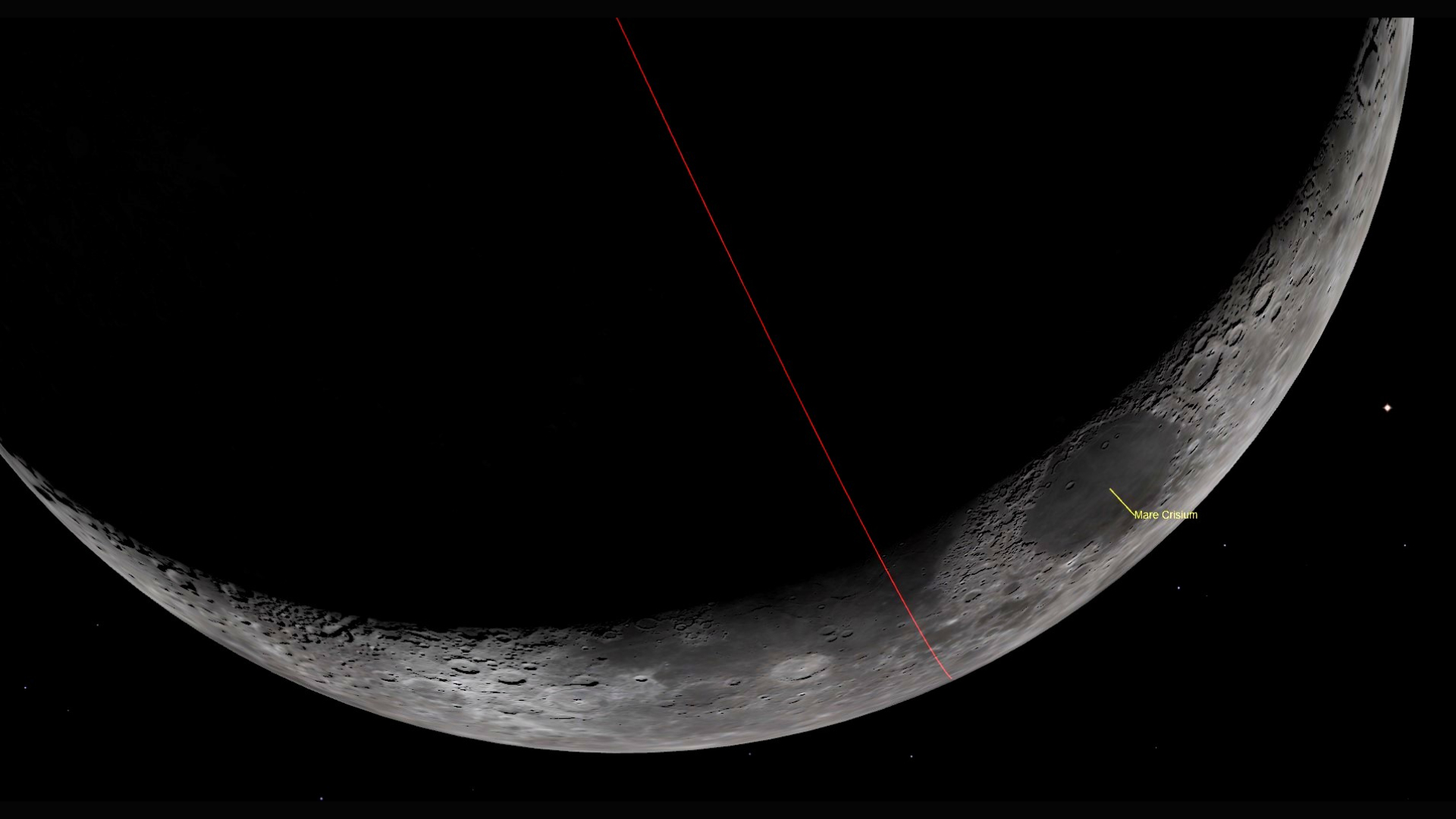
On Wednesday evening, Jan. 21, the dark oval of Mare Crisium will be framed inside the appealing crescent of the young moon. Several evenings after the new moon phase every month, this 345-mile (556 km) diameter basin becomes easy to see using your unaided eyes, binoculars, and any telescope. It is located near the eastern edge of the moon, just north of the moon's equator (the up-down red curve). The wobble of the moon, known as lunar libration, shifts Mare Crisium higher and lower, and closer and farther from the moon's edge at various times.
Thursday, Jan. 22 - Crescent moon meets Saturn and Neptune
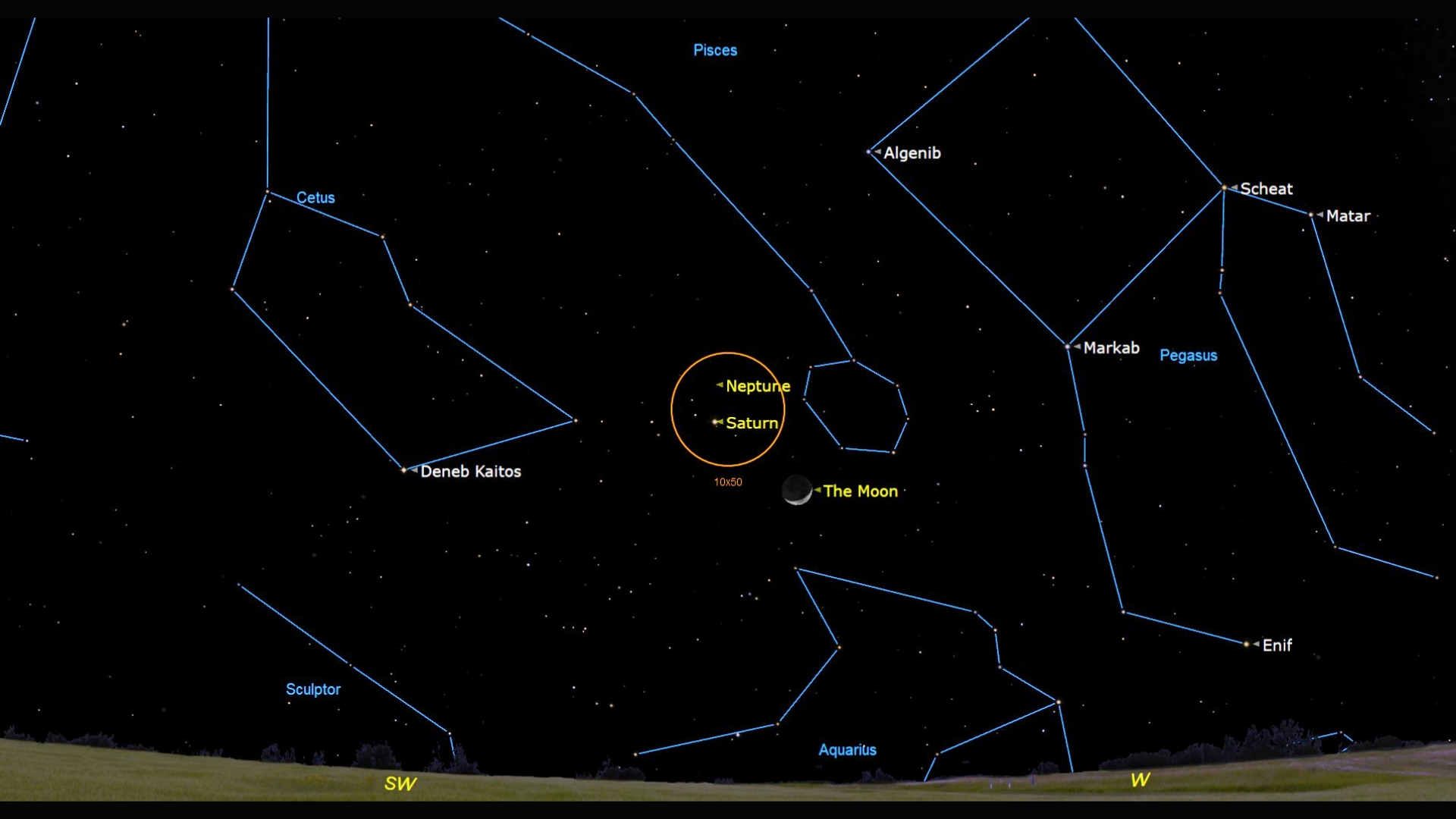
As the sky darkens after sunset on Thursday, Jan. 22, look halfway up the southwestern sky for the prominent, creamy-yellow dot of Saturn shining a palm's width to the upper left (or 6 degrees to the celestial east) of the waxing crescent moon.
Once the sky is fully dark, use binoculars (orange circle) or a backyard telescope to see the faint, blue speck of Neptune positioned a thumb's width above Saturn. The trio will drop below the rooftops in the southwest after mid-evening.
Saturday, Jan. 24 - View Rupes Altai (all night)
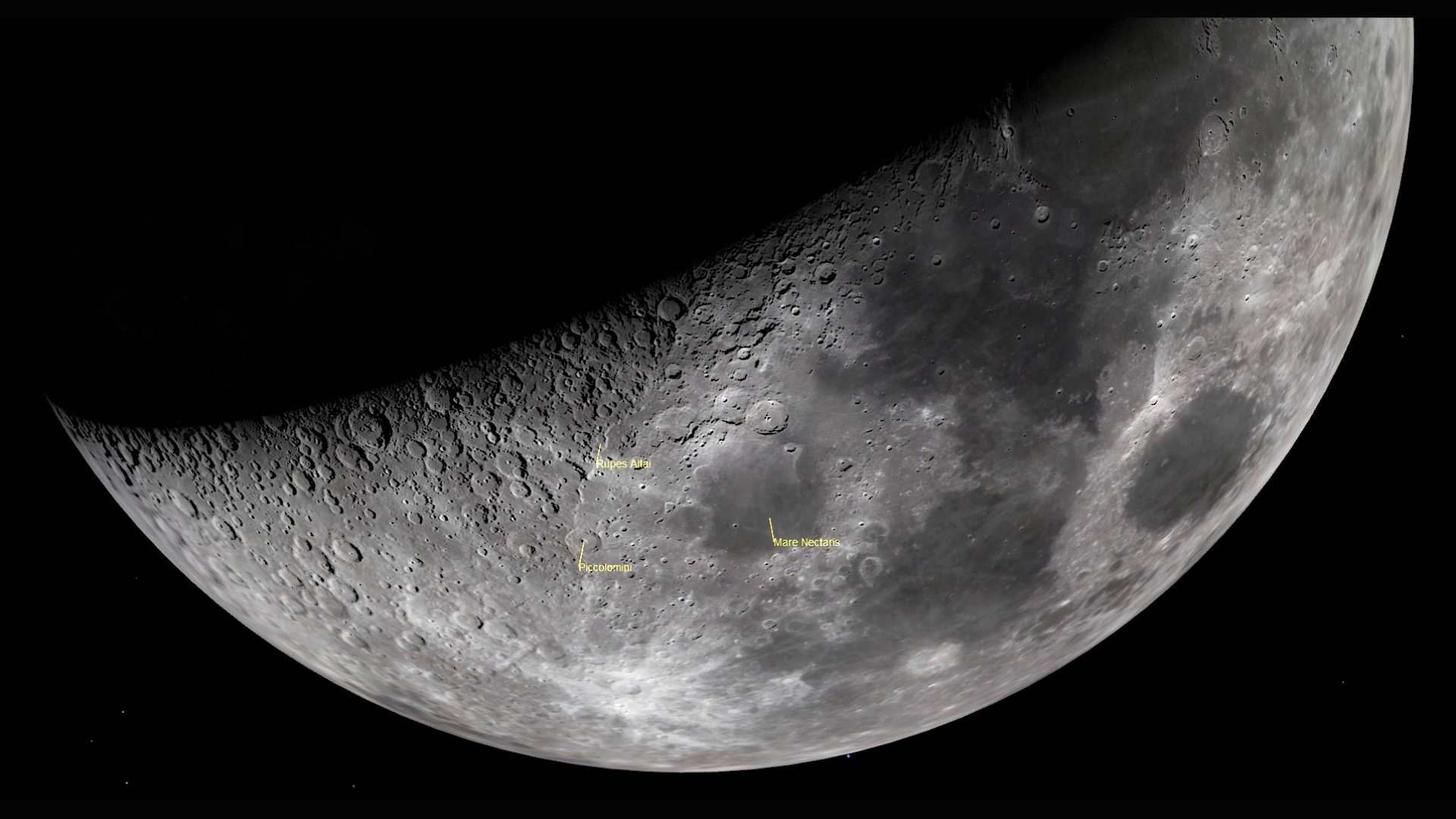
On Saturday night, Jan. 24, the curved terminator on the moon will fall just to the upper left (or lunar west) of a large, curved escarpment on the moon known as Rupes Altai, making that feature especially easy to see with sharp eyes and through binoculars and telescopes.
The cliff, which climbs up to 0.6 miles or 1 km above the lunar surface, is actually part of the rim of ancient Mare Nectaris. Its curve runs parallel to the edge of that large, dark basin, which will appear to its upper right (lunar northeast), though partly in shadow. Watch for the large crater named Piccolomini straddling the southeastern end of the cliff. Rupes Altai is highlighted every lunar month when the waxing moon is about 5 days past new and again when the waning moon is approaching third quarter.
Sunday, Jan. 25 - The lunar X (peaks at 6 p.m. EST)

Several times a year, for a few hours near the moon's first quarter phase, patterns on the moon called the Lunar X and Lunar V become visible in strong binoculars and backyard telescopes (inset). The Lunar X is located on the terminator south of the crater La Caille, about one third of the way up from the southern pole of the moon (at 2° East, 24° South). The "V" is located near the crater Ukert (at 1° East, 14° North). On Sunday, Jan. 25, those letter shapes are predicted to start developing by 4:30 p.m. EST (or 11:30 GMT) in a twilit sky for the Eastern time zone, peak in intensity around 6 p.m. EST (or 23:00 GMT), and then disappear by 7:30 p.m. EST. The Lunar X and V will be observable in any time zone on Earth where the moon is visible, especially in a dark sky, between those hours.
Monday, Jan. 26 - First quarter moon

The moon will complete the first quarter of its 29.53-day trip around Earth on Monday, Jan. 26 at 04:47 GMT, which converts to Sunday evening at 11:47 p.m. EST and 8:47 p.m. PST in the Americas.
At first quarter, the moon's 90-degree angle from the sun causes us to see it half-illuminated on its eastern side among the faint stars of Pisces. First quarter moons always rise around midday and set around midnight, so they are also visible in the afternoon daytime sky. The evenings surrounding first quarter are the best ones for seeing the lunar terrain when it is dramatically lit by low-angled sunlight, especially along the terminator, the pole-to-pole boundary that separates the moon's lit and dark hemispheres.
Tuesday, Jan. 27 - Bright moon shines near the Pleiades (evening)

On Tuesday evening, Jan. 27, in the Americas, the waxing gibbous moon will shine a short distance to the left (or celestial northeast) of the stars in the prominent Pleiades star cluster, which is also known as Messier 45, Subaru, and the Seven Sisters.
For those viewing the meetup later or from more westerly time zones, the moon's eastward orbital motion will carry it farther from the cluster while the diurnal rotation of the sky lifts the moon above the Pleiades. While the glare of the moon will hide the cluster's stars from your unaided eyes in a fully dark sky, viewing the encounter during evening twilight, especially through binoculars (orange circle) or a backyard telescope, will allow you to see them better. The blue nebulosity around the Pleiades stars is only apparent with a very large telescope or a long exposure image.
Wednesday, Jan. 28 - Mercury climbs past Venus

For a short time after sunset on the evenings surrounding Wednesday, Jan. 28, the innermost planet Mercury will shine close to much brighter Venus just above the western horizon.
On Tuesday, binoculars (orange circle) will show Mercury a finger's width below (or 1 degree to the celestial SSW) of Venus. On Wednesday and Thursday, Mercury will be located less than a finger's width to Venus' lower left (or celestial south) and to Venus' left, respectively. On the following days, the speedy planet will climb up and away from Venus (red path), but they will remain close enough to share the view in binoculars until about February 8.
Be sure to wait until the sun has completely set before turning any optical aids towards the western horizon.
Thursday, Jan. 29 - Mare Imbrium mountains (evening)
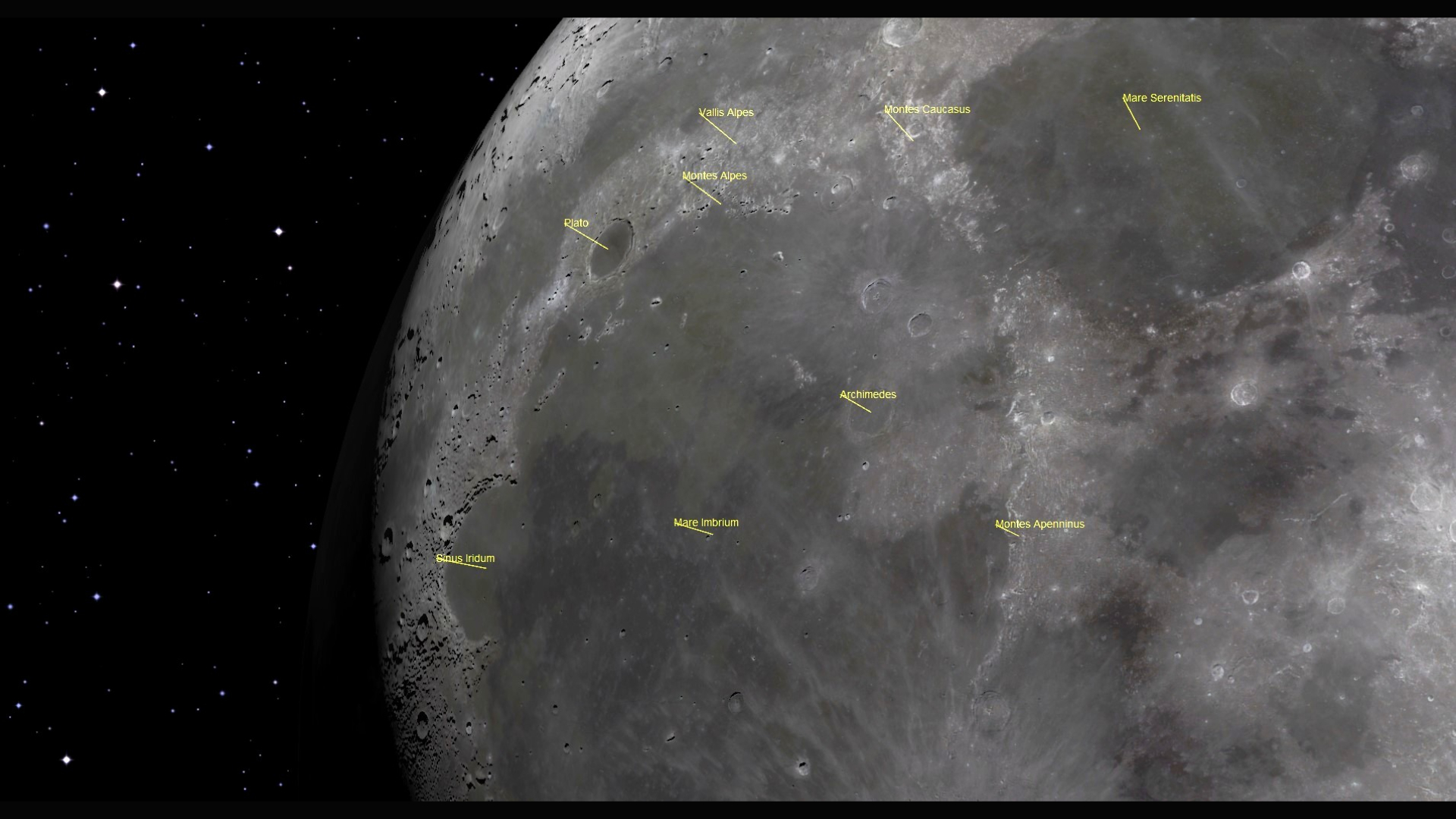
Thursday, Jan. 29, will offer a fine opportunity to view the spectacular mountain chains, actually segments of the old basin's rim, that encircle the rim of Mare Imbrium. The most northerly arc of mountains is the Lunar Alps, or Montes Alpes.
Binoculars or a telescope will reveal a slash cutting through them called the Alpine Valley, or Vallis Alpes, where the moon's crust has dropped between parallel faults. To the lower right (lunar southeast) of the Alps are the Caucasus Mountains, or Montes Caucasus. That mountain range disappears under a lava-flooded zone connecting Mare Imbrium with Mare Serenitatis to the southeast. The southeastern edge of Mare Imbrium is bordered by the lengthy Apennine Mountains, or Montes Apenninus. They sink out of sight near the prominent crater Eratosthenes. The Montes Carpatus ring the south, near crater Copernicus. On the opposite side of the mare is the distinctive, round Sinus Iridum, the Bay of Rainbows.
Friday, Jan. 30 - Bright moon joins Jupiter in Gemini
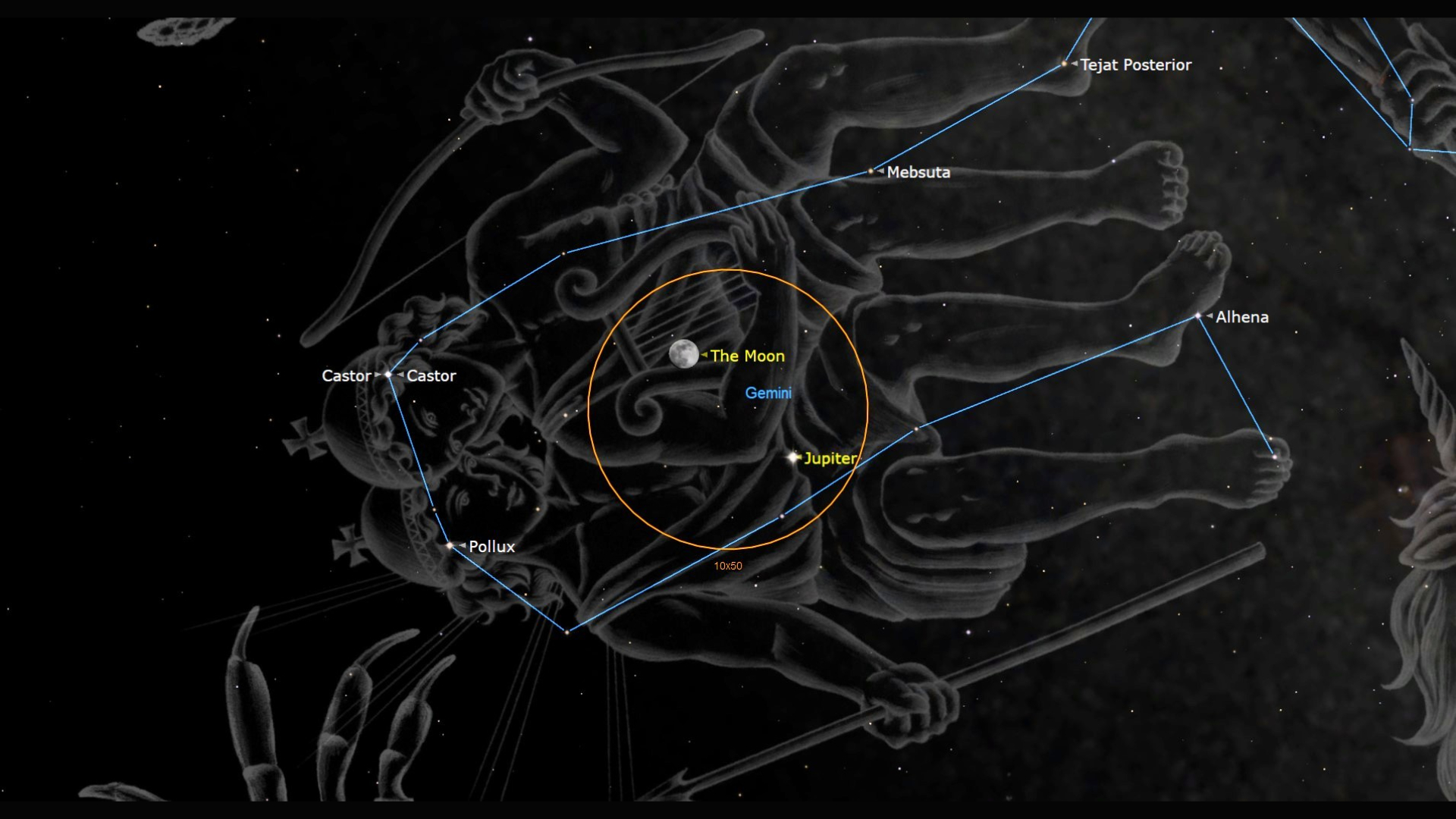
In the eastern sky on Friday evening, Jan. 30, the bright, waxing gibbous moon will shine in central Gemini above the brilliant planet Jupiter.
The moon and Jupiter will cross the sky all night long while the moon's orbital motion carries it directly towards Gemini's brightest star, Pollux. In the western sky before dawn on Saturday morning in the Americas, the moon will be aligned between Jupiter and Pollux, making a spectacular visual and photo opportunity.
Visible planets
Mercury

For observers at mid-northern latitudes, Mercury will be visible just above the eastern horizon before sunrise during the first few mornings of 2026, but viewers at tropical latitudes will be able to see the speedy planet until mid-month.
Mercury will eventually disappear into the sun's glare and pass our star at superior conjunction on Jan. 21. When it reappears above the western horizon after sunset at month's end, it will shine just to the left (or celestial south) of much brighter Venus. The two planets will be closest on the evenings surrounding Jan. 28-29. Telescope views of Mercury at either end of the month will show a 95%-illuminated gibbous phase and an apparent disk size of 5 arc-seconds.
Venus

Venus will be hidden until after it passes the sun at superior conjunction on Jan. 6. The brilliant magnitude -3.9 planet will return to shine just above the western horizon after sunset during the final week of January. Mercury's faster climb away from the sun will carry it less than a finger's width to the left (or 1 degree to the celestial south) of Venus on the evenings surrounding Jan. 28-29.
Mars

Mars will not be visible during January. It will pass the sun on Jan. 9 and then join the eastern morning sky by the end of the month. Its small angular separation from the sun and its position on the far side of the solar system from Earth will keep the planet too faint to be observable against the brightening sky until February.
Jupiter
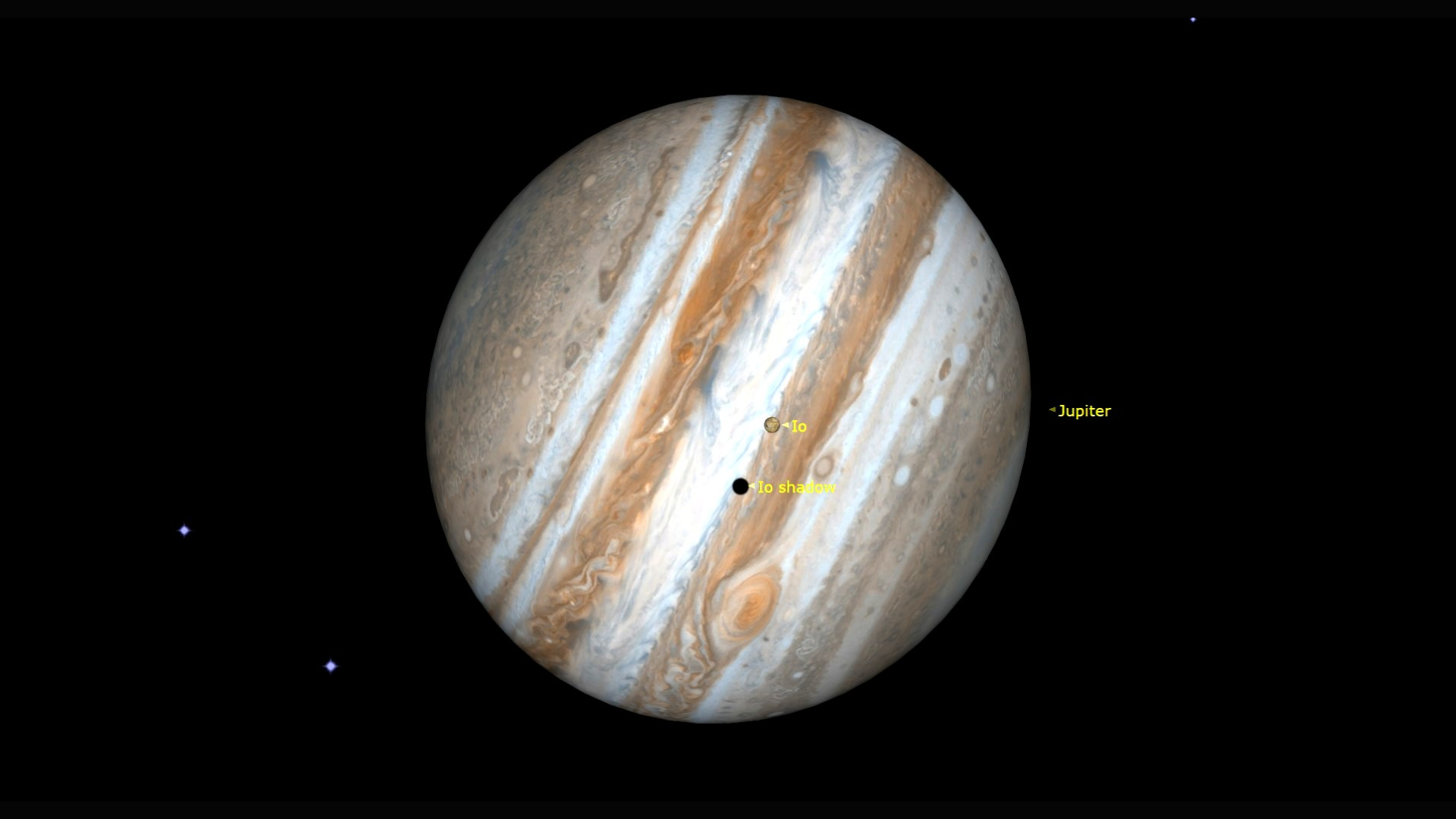
The extremely bright, white planet Jupiter will be well-placed for observing all night long during January. The gas giant will be marching westward toward, and then closely past, the bright star Wasat in Gemini at mid-month - forming an extra corner in the giant Winter Hexagon asterism. On January 10, Jupiter will reach opposition for 2026. Since Earth will be positioned between the sun and the planet on that date, Jupiter will rise at sunset, remain visible all night long, and set at sunrise.
At opposition, Jupiter will be "only" 393.3 million miles, 633.1 million km, or 35 light-minutes from Earth, and it will shine at its maximum brightness for 2025 magnitude of -2.7. Jupiter passed perihelion in January 2023, so the planet's generous, 46.6 arc-seconds-wide disk will shrink a little more at each opposition for the next several years. Binoculars will reveal Jupiter's four large Galilean moons flanking the planet on any night, and views of Jupiter in a backyard telescope will show its equatorial zones and belts. Better quality optics will reveal the Great Red Spot on every 2nd or 3rd night. Around opposition, Jupiter's Galilean satellites appear larger and brighter and frequently eclipse and occult one another, while the round, black shadows they cast upon the planet can be seen crossing Jupiter's disk. The bright, waning gibbous moon will create a lovely photo opportunity when it shines between Jupiter and Gemini's two brightest stars, Castor and Pollux, on Jan. 3 and 30.
Saturn

Saturn will be well-positioned for viewing during early evening for all of January, although its steady shift sunward will see it set in mid-evening by month's end, shortening its best viewing hours in telescopes. The Ringed Planet's prominent, magnitude 1.15 creamy yellow dot will pop out of the twilight in the southwestern sky at dusk, outshining nearby Neptune and the faint constellations of Aquarius, Pisces, and Cetus that surround those two planets.
Viewed in a telescope, Saturn will show an apparent disk diameter of about 16.7 arc-seconds and its extraordinary rings will subtend 39 arc-seconds. The rings, which were fully closed around their equinox in March 2024, will continuously widen for the next several years, revealing their southern side. This month, they will open from a tilt of -1.0° to -2.2°. While Earth remains near the ring plane, Saturn's moons will appear close to the planet's equator and produce occasional shadow transits.
Saturn's eastward orbital motion during January will carry it from northeastern Aquarius into Pisces on Jan. 15 and halve its separation southwest of slow-moving Neptune from 3.4 to 1.7 degrees. The waxing crescent moon will shine nearby on Jan. 22 and 23.
Uranus

Uranus will be well-placed for observing from the end of twilight to beyond midnight during January while it shines close to the ecliptic and less than a palm's width to the lower right (or 4 degrees to the celestial south) of the bright Pleiades Cluster.
The magnitude 5.6 blue-green planet is visible in a backyard telescope and through binoculars on moonless nights. Its westerly retrograde motion through western Taurus will slow as it prepares to reverse course and resume regular eastward motion early next month.
Neptune

During January, the distant, magnitude 7.9 planet Neptune will be located in the southwestern evening sky among the stars of western Pisces and a short distance to the upper left (or celestial east) of 560 times brighter Saturn, though the window for viewing both planets will diminish as they are carried closer to the sun every day. Neptune's slower orbital motion will allow faster Saturn to reduce its separation from 3.4 to 1.7 degrees over the month. Viewed through a backyard telescope in a dark sky, Neptune's 2.3 arc-second disk will resemble a dull blue star.







